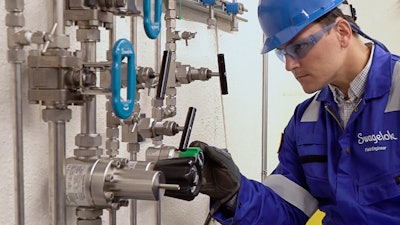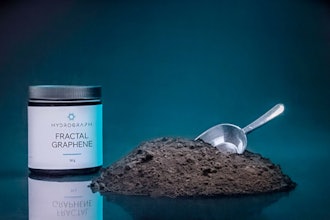
Industrial fluid systems play an important role in transporting high-pressure, high-temperature liquids and gases in a variety of industrial applications. It is critical to optimize the performance of these systems to help ensure the safety of plant workers and technicians, as well as the quality of the end product.
For example, a leaking fluid system can both alter the chemical composition of a product and can endanger staff. The following checklist can help you avoid these problems, while also enhancing the performance of your systems.
Do Not Overcomplicate the Design
The more complicated an industrial fluid system is, the more chances there are for failure. By simplifying the system’s design, that becomes less of a concern. For example, piping runs that change directions frequently will have several pipe fitting connection points, all of which could fail under the right circumstances. If, instead, the design uses bendable tubing, the number of potential leak points and other failures is significantly reduced.
 Simplify Designs: Fewer connection points with bendable tubing (left) instead of piping (right) mean fewer opportunities for failure.Swagelok Company
Simplify Designs: Fewer connection points with bendable tubing (left) instead of piping (right) mean fewer opportunities for failure.Swagelok Company
It is also possible to simplify designs by purchasing prefabricated system assemblies from a trusted supplier. Such assemblies include grab sampling systems, mechanical seal support systems, gas distribution systems, or analytical subsystems. By outsourcing the fabrication of critical systems, plant managers can overcome potential resource constraints – but it is important to choose the right vendor so that the systems improve operations. Engineering expertise, stringent testing, and high-quality components and materials are essential characteristics of the right partner, along with proactive assistance from design teams who work to meet specific needs with repeatable custom or routine solutions.
Specify the Right Componentry
Choosing the right components for your system means it is vital to have a complete understanding of process conditions.
 Specify Proper Componentry: Consider process conditions and material compatibility when selecting components.Swagelok Company
Specify Proper Componentry: Consider process conditions and material compatibility when selecting components.Swagelok Company
For example, if your fluid system generates a static charge, you want to use a hose with a conductive metal core or PTFE core with carbon black to dissipate static rather than discharge it through the hose’s core. Selecting the right material for the job will help to prevent future leakage.
In addition, fluid system tubing materials should be designed to work together with the proper hardness to stay connected. For example, do not use brass fittings with stainless steel tubing because the fitting material is too soft to provide enough hold on the tube.
Lastly, assembly-by-torque (AbT) fittings are designed to meet the requirements of alternative fuel transportation applications and provide reliable and repeatable assembly. Their design helps installers make consistent, leak-tight tube connections that resist vibration.
Avoid Component Intermix
Components from different manufacturers are not interchangeable and can cause potential leaks and related safety problems.
 Avoid Product Intermix: Intermixing components made by different manufacturers can result in unpredictable performance and leaks.Swagelok Company
Avoid Product Intermix: Intermixing components made by different manufacturers can result in unpredictable performance and leaks.Swagelok Company
Consequently, plant managers should not interchange and intermix components from different manufacturers because the incompatibility could increase the potential for poor performance. Leak-tight seals that can withstand rigors such as high pressures, vibration, vacuum, and temperature changes, are vital to the successful operation of industrial fluid systems. Selecting tubing and fittings from the same reliable manufacturer can help ensure optimal system performance and reliability.
Follow the Manufacturer’s Instructions
Though it may seem obvious, technicians should be sure to follow the manufacturer’s instructions for proper assembly and disassembly of the system once the components are selected from the same manufacturer.
 Follow Manufacturer’s Instructions: Abide by guidelines for proper assembly and disassembly procedures for tubing and fittings.Swagelok Company
Follow Manufacturer’s Instructions: Abide by guidelines for proper assembly and disassembly procedures for tubing and fittings.Swagelok Company
Sometimes, it requires a close reading of the specific directions to ensure they are being properly installed. Taking these extra precautions can help plants avoid errors such as:
- Under-tightening fittings, which creates opportunities for leaks and blowouts
- Not ensuring tubing rests firmly on the shoulder of the tube fitting body before tightening
- Failing to properly check tubes for ovality, defects, or scratches that can compromise a seal
- Failing to check extremes of wall thickness against the fitting manufacturer’s suggested limitations
- Failing to use a proper gap inspection gauge to ensure sufficient fitting pull-up
Keep Operating Conditions in Mind During Design
While assembling a fluid system, it may be easy to forget about the standard operating conditions like vibration, high pressures, and temperature changes because the system is not actively running.
 Consider Operating Conditions During Design: Be sure to plan for regular operating conditions like vibration, high pressures, and temperatures.Swagelok Company
Consider Operating Conditions During Design: Be sure to plan for regular operating conditions like vibration, high pressures, and temperatures.Swagelok Company
It is important to keep these factors in mind during downtime to minimize future risks, such as a blowout, when the system restarts its operations.
For example, proper supports are used to prevent tubes and fittings from becoming fatigued from high-pressure use. Consider that components may move when in operation, which can strain the system’s connection points. Finally, in instances where there may be significant vibration, technicians should consider using hoses instead of tubing. In doing so, be sure to distribute movement over a sufficient length to prevent any bends that are smaller than the hose’s minimum bend radius.
Label Critical Components
Finally, it is important to label all, even seemingly less critical, parts of your fluid system.
 Label Critical Components: Detailed tags on components like hoses and valves indicate system parameters so operators can make streamlined adjustments and replacements.Swagelok Company
Label Critical Components: Detailed tags on components like hoses and valves indicate system parameters so operators can make streamlined adjustments and replacements.Swagelok Company
Tags are a cost-effective way to improve efficiency by allowing easy identification of products and are effective in establishing preventive maintenance programs. Tagging items like pumps, hoses, valves, or other key parts allows technicians to proactively identify when a component should be replaced to avoid downtime and costly fixes.
Additionally, tagging can help identify specific issues or faults that have developed on-site. By recording issues this way, the maintenance team will have both a record and a specific location that members can use to quickly identify the item that needs to be replaced.
Tags should be labeled with the proper information, including part number, date of manufacture, and the trace identification number, which ties the product to the original order. System media, operating pressure, and temperature are also valuable information that can be included.
Check off these boxes, and you will be well on your way to safer industrial fluid system operation – with the likely bonus of improved quality.
Mike Frost is the Regional Area Manager, Field Engineering (Asia-Pacific) for Swagelok Company.
An original version of this article appeared on the Swagelok Reference Point blog.






















